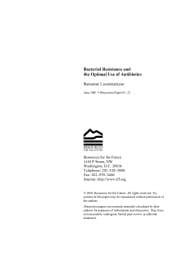May 27, 2010

The Question
Incorporating fitness cost of resistance into the model, what is the optimal use of antibiotics differing in resistance levels? And what is effect of the nonconvexities in antibiotic treatment costs on the optimal antibiotic use strategy?
What we found
Given two drugs, the one with the lower fitness cost should be used exclusively until resistance to the two is of the same ratio as their respective fitness costs. Thus, it is sometimes socially optimal to use a less effective drug. This does not coincide with the private optimum to always be treated with the most cost-effective drug. With nonconvexities in treatment costs, simultaneously treating equal fractions of the population with two antibiotics may be inefficient. When cycling antibiotics, the cost of switching is critical in determining the duration each antibiotic should be used.
Why it matters
Antibiotic treatment cures infected individuals, but at the same time it increases resistance and reduces future treatment effectiveness. The fitness cost of resistance raises additional complexities, more resistant strains are less adapt to survival when no antibiotics are used. For these reasons and due to the intertemporal dynamics of antibiotic use, the study of antibiotics differs from that of standard natural resource models.

